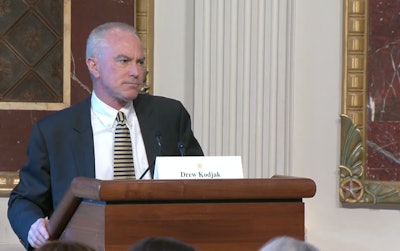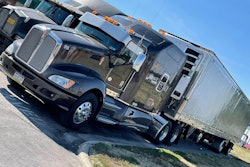
The Biden administration on Wednesday announced more than $1 billion in funding and incentives it hopes will spur the transition to zero-emission heavy-duty trucks.
The White House in March laid out its plan to establish a charging and refueling infrastructure network for zero-emission commercial trucks, an initiative that seeks to maximize the impact of charging infrastructure investment by guiding development toward high-volume-priority corridors and existing freight hubs.
The plans made public Wednesday support the corridors' development and President Biden’s goals for a carbon pollution-free energy sector by 2035, and for achieving net-zero emissions from the transportation sector by 2050.
Drew Kodjak, who serves as senior director of transportation emissions in the White House Climate Policy Office, noted Wednesday that the corridor strategy was not started from scratch and "not only did we have a strategy, a lot of the work that is being done to make investments in infrastructure are aligning beautifully with that strategy. It's not really surprising, frankly, because most of the strategy is built around where most of the freight is; where the big opportunities are."
Kodjak noted than 170 zero-emission corridor projects have been collected for consideration "over the course of the last several weeks," including 5,000 EV ports for heavy-duty freight charging, more than 50 hydrogen dispensers, "and daily services for 12,000 zero-emission medium- and heavy-duty zero-emission vehicles."

The Environmental Protection Agency (EPA) said Wednesday it is making available $1 billion in funding for cities and states through the Inflation Reduction Act to replace fossil fuel-fired Class 6 and Class 7 vehicles, including school buses, refuse trucks and delivery trucks, with zero-emissions vehicles. The funding will support infrastructure to charge, fuel and maintain heavy-duty zero-emission vehicles, along with workforce development and training to get this work done. At least $400 million of the program’s funding will serve communities dealing with significant air pollution.
The Department of Transportation (DOT) announced the first tranche of its $400 million Reduction of Truck Emissions at Port Facilities Grant Program to improve air quality and reduce pollution for truck drivers, port workers and families that live in communities surrounding ports. The Department of Energy (DOE) is also announcing a $72 million investment to establish a “SuperTruck: Charged” program that will demonstrate how vehicle-grid integration enables depots and truck stops to provide affordable, reliable charging while increasing grid resiliency.
The National Zero-Emission Freight Corridor Strategy, developed by the Joint Office of Energy and Transportation and the DOE, in collaboration with the DOT and EPA, is based on a focused buildout around freight and trucking return-to-base depot infrastructure, regional hub-to-hub corridors and national network nodes. It was drafted to meet growing market demands by targeting public investment to amplify private sector momentum, focus utility and regulatory energy planning, align industry activity and improve air quality in local communities heavily impacted by diesel emissions.
Trucking groups, in a report compiled by third-party Roland Berger, contended that such a rollout would cost upwards of $1 trillion and likely drive numerous trucking companies out of business and consumer prices soaring.
The Biden administration on Wednesday invited several stakeholders from commercial truck fleets, ports, vehicle manufacturers, state and local governments, utilities, infrastructure providers, and climate and environmental justice organizations to the White House for a roundtable-like discussion focused on supercharging the buildout of the infrastructure necessary to make a zero-emissions freight ecosystem a reality in the U.S. It is the first of a series of engagements aimed at tackling emissions from the movement of goods across the nation and recognizes the great progress made already by leaders in freight decarbonization.










